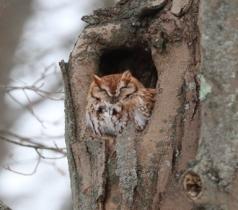
2 minute read
NATURE & CONSERVATION
Snags and Brush Piles
Why they are important for birds and should be incorporated into your yard by Jennifer
Advertisement
Cox
The Township is distinctive for its woodlands. Whether in a preserve, park or residential backyard, you are never far from woods. Although often unnoticed in woodlands, decaying wood and leaves are integral to the ecology. For example, snags and downed wood can provide important food and shelter for woodland birds that visit your yard.
Dead and Downed Wood
Creating Snags and Brush Piles
Snags: Birds use snags of all sizes. Any snag that you can safely and comfortably leave on your property will benefit wildlife. Larger snags: Pileated woodpeckers, northern flickers and owls require larger snags (taller, broader dead trees) for nest cavities. Note: Dead trees that pose a risk to structures should be removed, but some can be cut to a safe height and still provide opportunities for larger birds to create nest cavities that will eventually be used by cavity-nesting birds. Smaller snags: Chickadees, titmice, wrens, nuthatches, and downy woodpeckers can use smaller snags (such as dead saplings) or the dead branches of larger trees for nest cavities.
Snags and Tree Cavities
Snags are standing trees that are dead or dying. Snags provide a number of important benefits to wildlife. As a tree dies, its bark loosens and forms bark cavities. These cavities are used for roosting by forest-dwelling bats and as nest sites by small forest birds called brown creepers. Insects, a valuable food source for many species, are abundant in snags. A wide variety of birds (including flycatchers, raptors, and songbirds) also use snags as hunting and singing perches.
Tree cavities are holes that have been excavated in snags, often by woodpeckers. These holes are used for shelter and nesting by many species including owls, wood ducks, chickadees, titmice, nuthatches, wrens, bluebirds, and woodpeckers. There are over 35 bird species found in Pennsylvania that require cavities for nesting. Consider leaving some snags on your property to benefit wildlife.
Dead wood is also important for wildlife habitat. As logs and fallen branches decay, they return nutrients to the ground and support the insects on which many birds and animals feed. Amphibians, such as salamanders, rely on downed trees for cover by hiding on the moist undersides of fallen logs. Birds that rely on decaying logs and branches for food and shelter include eastern towhee, northern flicker, winter wren, pileated woodpecker, and thrushes. If your property has a wooded area, consider leaving leaves, logs and branches on the woodland floor to degrade naturally, nurture the soil, and provide food and shelter for birds and other animals. If you don't have woods, you can provide dead downed wood for wildlife while still keeping your yard tidy by assembling fallen logs and branches into a
Brush Piles: The best brush piles for wildlife start with the largest materials (branches or logs) at the bottom and end with the smallest materials (small limbs or shrubs) at the top of the pile. The materials are arranged so that the brush pile is raised slightly above the ground. This makes it easier for wildlife to get under the brush pile and into cover. It is best not to place brush piles close to structures.
Sources for this article include: https://extension.psu.edu/wildlife-habitat-relationships








